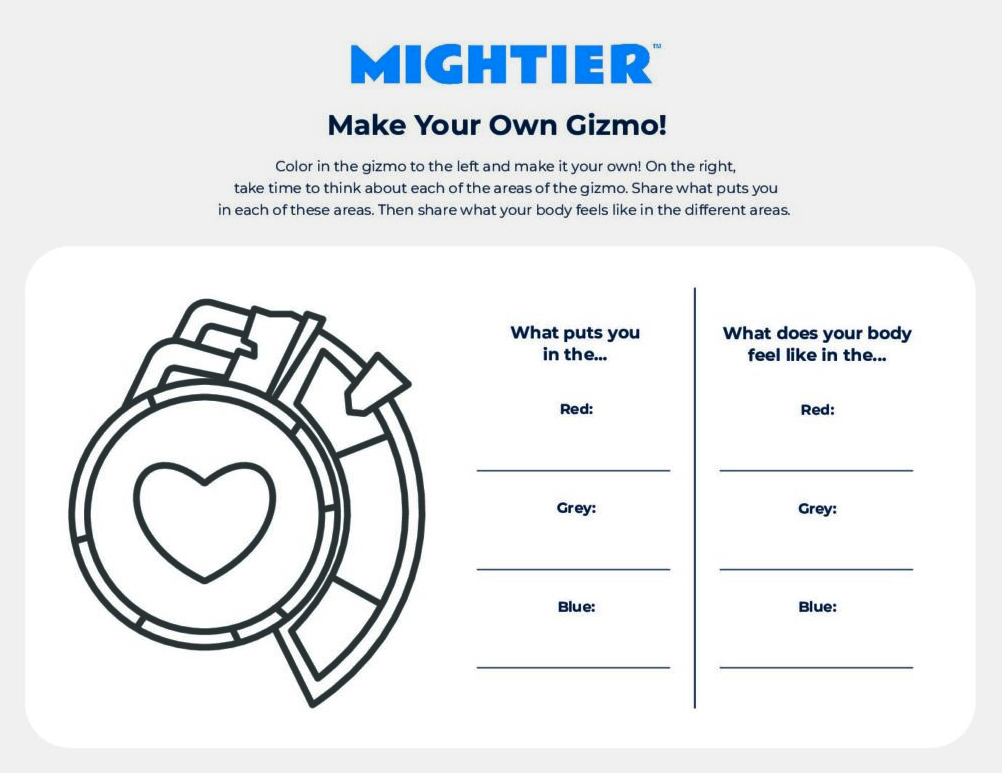- 15 to 20 minutes
- In person
- Teletherapy

Overview
This visual activity will help kids identify triggers and body cues associated with their emotions and different heart rates.
Time in Mightier program
Weeks 3+
Therapeutic Goals
- Provide psychoeducation regarding heart rate and body cues
- Develop emotional awareness
- Increase emotional vocabulary
- Practice self-reflection
- Support client’s understanding and enjoyment of Mightier
Documentation Suggestion
Client and clinician engaged in a psychoeducational intervention focused on identifying triggers and body cues associated with their emotions and different heart rates using the Mightier biofeedback tool’s language. The intervention helped the client to develop emotional awareness and increase their emotional vocabulary while practicing self-reflection.
Step-by-step instructions
-
- Ask your client to describe the Gizmo in Mightier. (Some kids may call this different things, so describing this Gizmo may be helpful).
- Describe what the Gizmo does and how it represents different body cues and emotions using the script below (or something similar).
Do you feel like you have a Gizmo inside yourself?
Have you noticed that the Gizmo moves when you feel different emotions or changes in your body?
What does the red on the Gizmo represent? (Allow the client to answer then provide psychoeducation).
The red on the Gizmo means our heart rate is high which can mean many things. It can mean we are really excited or happy. It can also mean that we are frustrated, angry, or worried. When we have a big feeling, our heart rate tends to go up. This is because our body and brain are working hard to alert us that there is something happening so we can make decisions. Sometimes when our heart rate is high, it can be harder to make decisions.
What does the grey on the Gizmo represent? (Allow the client to answer then provide psychoeducation).
The grey on the Gizmo represents that your heart rate is in the middle. It means your heart rate is headed up to the red or going down to the blue. The grey can act as a warning and may be when you don’t notice any changes in your body or emotions just yet.
What does the blue on the Gizmo represent? (Allow the client to answer then provide psychoeducation).
The blue on the Gizmo represents that your heart rate is low which can mean many things. It can mean we are calm, that we are focused, or that we are tired. Usually, when our heart rate is low we can make decisions and choices a bit more easily. - Explain to the client that they are going to make their own Gizmo today and reflect on what they notice about their body when they are in each of the sections.
- Show a picture of the Gizmo and have the client use the worksheet or draw their own on one side of the paper.
- Then ask your client to write (or draw) what they notice about their body when they are in each section of the Gizmo (red, grey, and blue) next to that section on their drawing. Ask questions about what they notice when they are feeling a certain feeling and give examples of what others may notice (i.e. “A lot of kids tell me that they are in the red they notice that they feel sweaty or like their fists are clenched”)
- Afterward, ask your client if they can identify situations that put them in the different sections of the Gizmo and to write (or draw) these situations next to them. Ask questions about situations in the past and give examples. (i.e. “Some kids tell me that when they get in an argument with their brother that they are in the red” or “Some kids tell me that when they read before bed they are in the blue”)
- Ask your client to describe the Gizmo in Mightier. (Some kids may call this different things, so describing this Gizmo may be helpful).



